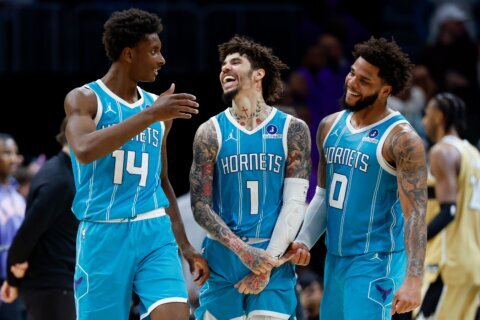What Gafford is working on this offseason originally appeared on NBC Sports Washington
The first thing Daniel Gafford did when his 2020-21 season ended was slow down. All players take their rest when they can, but for Gafford, it holds a different meaning.
Remember that talk during the season about his conditioning and how it related to the minutes he played? Gafford is all gas and no brakes on the court and that requires some cooling down time. That is especially the case after a season with few off-days in a truncated format due to the coronavirus.
“I’m really just taking my time because I’m pretty sure a lot of people have seen me, I’m 100 miles per hour on the court up and down the floor,” Gafford told NBC Sports Washington.
Once the dust settled following the Wizards’ playoff exit in June, Gafford knew where he wanted to start in his offseason training program. The regular season features enough downtime to stop and evaluate the big picture, but it can be difficult to change things on the fly.
That process was particularly difficult this season with very few practices. The Wizards went weeks without practicing down the stretch of the season, as they had to make up for lost time following six postponed games in January.
“I try during the season, but most of the time after the season is done, that’s when I really lock in and really just grind and work on the things that I want to be better at,” he said.
So, all along Gafford knew there were parts of his game he wanted to work on, he just had to wait until the offseason to really dive in. Some of his summer work has been in D.C. with Wizards assistant Alex McLean.
With Gafford already standing out as one of the Wizards’ best defensive players, he is putting much of his focus on the offensive end.
“I’m really just focusing on if I get the ball down in the post, working on my face-up game. Shooting the ball more, just trying to be more of a threat on the floor when I’m out there, during the times that I get on the floor,” Gafford said.
Gafford, 22, averaged 7.0 points, 4.3 rebounds and 1.1 blocks per game last season overall, but those numbers went up after he was traded to the Wizards from the Bulls in March. In 23 games with Washington, he averaged 10.1 points, 5.6 rebounds and 1.8 blocks all while shooting 68.1% from the field.
Gafford was impactful on offense, particularly as a dunker and lob threat. But there is certainly plenty of room for him to grow as a scorer.
As he mentioned, Gafford would like to create more shots for himself and one way would be facing up. Gafford has, through two NBA seasons so far, stuck to his strengths offensively. He has yet to attempt a single 3-point shot and has only taken 11 shots (out of 359) outside of 10 feet.
Gafford also rarely puts the ball on the floor. Last season, 95.1% of his shots came after one or fewer dribbles, according to Second Spectrum. He didn’t dribble at all on 76.8% of his shots attempts.
Facing up more often could mean shooting from a longer range or driving past his opponents in the midrange and post. It could also require more patience and awareness of timing, as Gafford generally acts very quickly with his offensive moves.
He’s not one to size up an opponent and then go to work with a dribble combination. But maybe some of that could be in his future, the tighter his handle gets and the more he understands how to change speeds.
“Whether it’s ball-handling, shooting; slowing down the game to where it’s my pace and just being able to play my game,” he said.
Gafford is going to be relied upon by the Wizards as their best rim-protector and perhaps their best defensive player overall. His counterparts in the big man rotation – Montrezl Harrell and Thomas Bryant – can’t protect the rim like he does but offer more in the way of scoring.
If Gafford can continue to add to his offensive game and close that gap, it will be hard to keep him off the floor.






